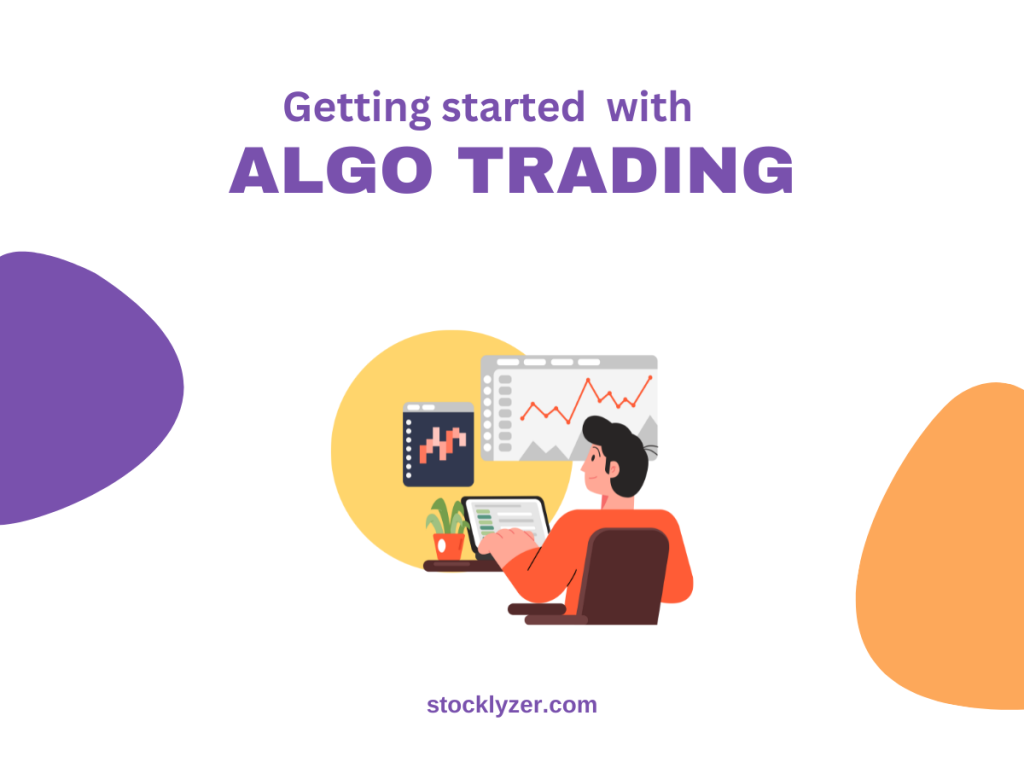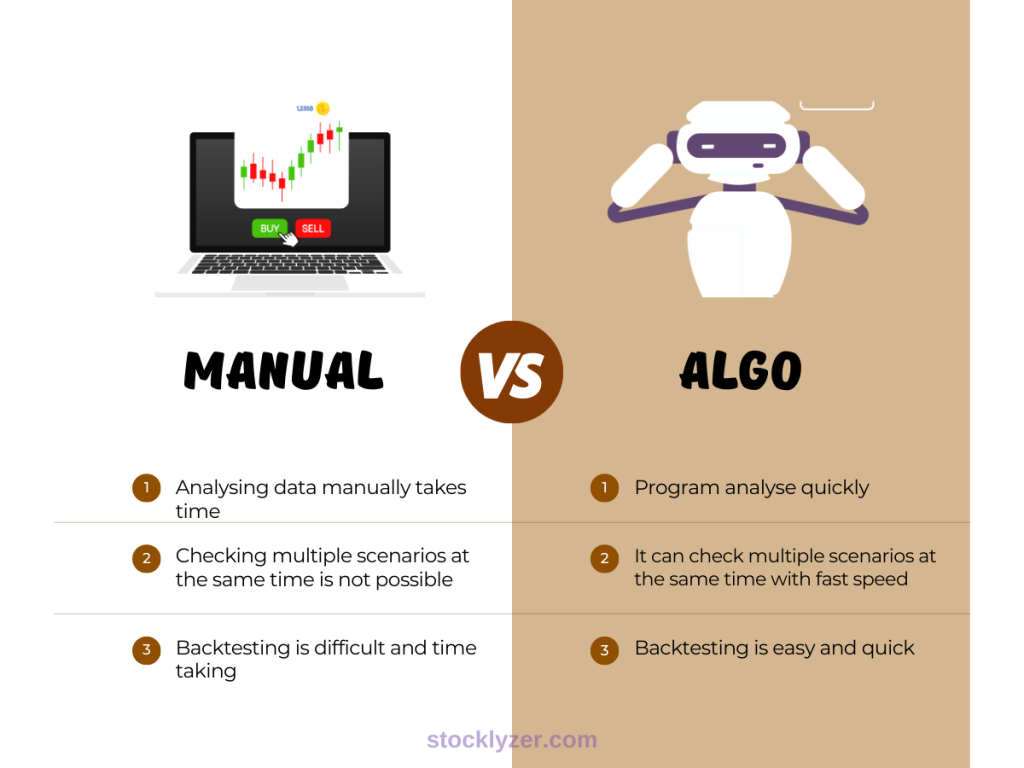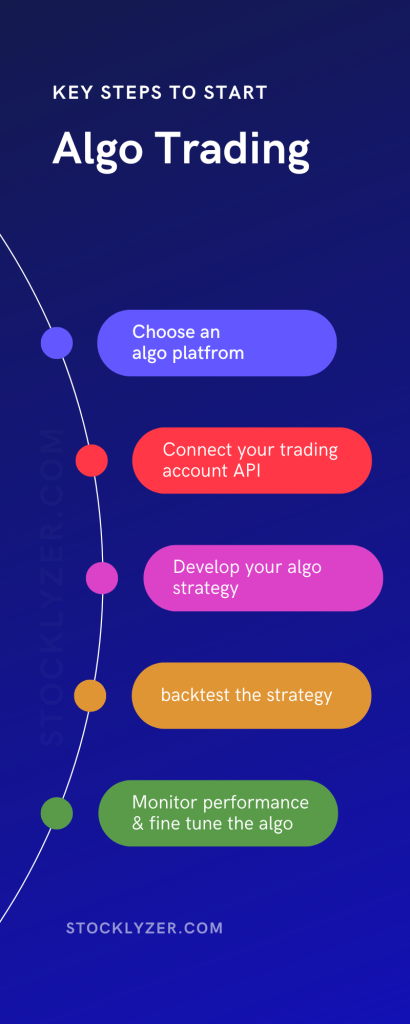In the fast-paced, ever-evolving world of trading, a new technology has stepped onto the stage – algorithmic trading or algo trading. More and more traders are turning towards this innovative method to optimize their trades. But why is that? Let’s take an exciting journey into the realm of algo-trading.

Algo trading is not a new concept in the market. In India, algo trading for institutions has been available for a long time. However, in recent years, there has been a significant development where many emerging brokers started offering API access.
This advancement has opened the doors for retail traders to venture into algo trading as well. Now, they can access and use these APIs to implement their own automated trading strategies.
What is algo trading?
Every trader has a unique set of rules for trading in the stock market. When these strategies are transformed into computer programs to verify each rule and execute trades automatically, it is referred to as algo trading.
Thus, in simple terms, algo trading is an automated trading system that executes orders based on pre-established strategies. Beyond this algo trading also has many more advantages.
Advantages of algo trading?
Algo-trading employs complex algorithms that execute trade orders based on predefined conditions such as price, volume, and timing. Let’s explore some compelling reasons behind its escalating popularity.
1) Speed & accuracy
The most potent advantage of algo-trading lies in its incredible speed. Computer analyse the data in almost no time. Plus, they eliminate manual errors enhancing accuracy significantly.
Computers analyze data in seconds, replacing manual chart analysis for traders. Algorithms execute orders swiftly based on signals, reducing research workload and providing a trading advantage.
2) Emotionless decisions
Trading decisions fueled by emotions often lead to costly mistakes. However, with algo-trading’s cold-blooded calculations there is no room for emotional interference. Controlling emotions is the biggest thing for a trader. Algo trading execute purely based on predefined strategy without any emotion.
3) Backtesting capability
This is best thing that algorithmic trading enables. Traders can test their algorithmic strategies on historical data before deploying them live, allowing for optimization and fine-tuning based on past performance results.
4.) Capable to do more complex calculations
An algorithmic trading strategy holds a remarkable advantage over human traders in its ability to leverage multiple indicators and perform complex calculations at lightning speed. Unlike humans, whose cognitive capacity is limited by time and processing capabilities.
It could also increase the liquidity in the market here is a report by Berkeley Does algorithmic trading improve liquidity
So now we understand why modern-day traders are increasingly leaning towards adopting this tech savvy approach called ‘algo-trading’. But there are some disadvantages of this system.
Disadvantages of Algo trading
While algorithmic trading, or algo-trading, offers numerous advantages to traders, it is essential to acknowledge that no trading method is without drawbacks. It is important to explore its disadvantages and challenges.
1) Short life span of algorithms
In fast paced marked, Almost 98% of the algorithm failed to work after a short time span. Algorithmic trading is not a simple “set-it-and-forget-it” solution as often advertised. Continuous fine-tuning and adaptation are necessary to keep algorithms effective in the dynamic and fast-paced market.
2) Regulations
Another disadvantage of algorithmic trading is the heavy regulatory scrutiny it attracts. Regulatory authorities across various countries are yet to agree on its legal status. Numerous restrictions imposed on this form of trading must be considered and addressed before one can decide to begin such operations.
3) Competition make the algos less effective
The popularity of algorithmic trading has led to increased competition. Successful algorithms can become less profitable as more market participants adopt similar strategies.
Difference between Manual trading and Algo trading
Let’s find out a quick difference between manual trading and algo trading.
| Manual Trading | Algo Trading |
|---|---|
| Manual technical data analysis and order placing takes time. | Automatic analysis and order placing make it fast. |
| Checking multiple stocks or markets at the same time is not possible by human. | It can check multiple markets or stocks at the same time. |
| Backtesting is difficult and time consuming | Backtesting is quick and easy |
| Human emotions involves | No room for human emotions |

What you require to start algo trading?
1. Demat & trading account
You need to open a Demat and trading account with a SEBI registered broker. You can check the list of all the SEBI registered stock brokers in India.
Consider factors such as brokerage charges, trading platforms, customer service, research and analysis tools, and any additional services they offer.
If you are new then this article could help you
2. API access of the trading account
Check if your broker is providing API (Application Programming Interface), which is required to place the orders automatically through computer program.
If you existing broker is not providing this then you can open another trading account. Don’t worry it is legal to open multiple demat account with multiple brokers.
3. Algo platform or own developed program
After getting API access. Now either you write your own program using a programming language like Python, Java or PHP etc. If you are not a programmer then use a third party algo trading platform. They provide facility to make your own strategy for algo trading. Check the best algo trading service provider in India.
To start algo trading, here are some key steps
1) Educate yourself
Gain a solid understanding of financial markets and technical analysis. programming languages like Python or Java is additional. This knowledge will be essential in developing your own strategies. If you are just a beginner read how to start trading wisely.
2) Choose algo platform
Select a reliable online platform that provides access to real-time market data and allows you to automate your trading strategies. Or if you have programming skills you can code your own program.
Check the best algo trader software. Or you can learn coding on the internet here is an example to start algo trading in python. You can find more on youtube or other tutorial websites.
3) Connect your broker with API
You need API access from your broker to connect to your trading account to automate the trades. In India you need to login to your algo platform daily with your broker account API to make algos work. Check the list of brokers providing API access for Algo Trading.
4) Develop your strategy
Create or customize an algorithmic strategy that aligns with your risk tolerance and investment goals. Many algo platforms also provide facility to copy strategy from other successful traders. Or some platform also provide prebuilt strategies, which you can refine further for better results. Test it thoroughly on historical data before deploying it live in the markets.
5) Backtest your strategy
Use backtesting tools provided by your chosen platform to evaluate the performance of your strategy over past market conditions. This step helps identify any flaws or areas for improvement.
6) Start small
Begin with small investments while learning how to manage risks effectively. Gradually increase your capital allocation as you gain confidence in your strategy’s profitability.
7) Monitor performance & fine tune
Regularly monitor the performance metrics of your algo trading system to ensure its effectiveness remains consistent over time. Refine it further if its effectiveness is decreasing.
Remember that successful algo traders continuously refine their strategies based on changing market conditions—so stay curious, adapt quickly, and always keep learning.

Will algo trading give guaranteed profit?
There is no guarantee that algo trading surely will give you profit. Algo trading just enable the automation of your manual strategy. If a trader’s manual strategy is working then surely algorithmic trade will also work otherwise it will not.
Though algo trading enables traders to monitor multiple indicators which can make the trades more accurate but it require lots of work to fine tune the algo and there is fear of overoptimization as well.
Is algo trading legal in India?
Yes it is legal in India but with some restrictions. There are some limitations, as per my experience and knowledge, in India to make it fully automatic it require algorithm to be approved from SEBI which is not an easy process.
Otherwise it require to login once daily and need to click on button to execute the order. So manual intervention is required in India.
Though some unregistered algo trading service providers claim for the fully automatic execution, but I have not tested them. Because they are not SEBI approved, so I have not tried to test them.
Another fact is that no registered broker in India is providing facility for algo trading but more and more brokers has started providing API access.
The Securities and Exchange Board of India (SEBI) has been actively trying to regulate algo trading to address concerns about mis-selling and potential risks to investors. In the past, SEBI issued cautions against unregulated algo trading services and proposed a framework to classify API-based trades as algo orders.
However, the proposed framework was flawed and could have hindered the booming API industry. SEBI’s core concern seems to be the quoting of past performances and predictions of future performance in algo marketing, although similar practices are common in other investment areas.
SEBI’s concerns regarding algo trading
https://www.nseindia.com/trade/platform-services-non-neat-decision-support-tools-algorithm-trading
Check out the best algo trading platforms supporting Indian stock market.
Algo trading in India
Here’s how algorithmic trading works in India
1. Regulation: In India, all stock exchanges operate under the regulation of Securities and Exchange Board of India (SEBI). SEBI has laid down guidelines for algorithmic trading which every market participant must adhere to.
2. Trading Process: Traders provide specifications about their desired trades to programmers who code these instructions into computers; this software then executes trades automatically when specific conditions are met.
3. Co-location Services: Indian Stock Exchanges like NSE and BSE offer co-location services where brokers’ servers are kept at the same location as that of the exchange server leading to reduced latency time.
4. Algorithm Approval: Before implementing a new algorithm for live-trading purposes it needs approval from respective exchanges ensuring its compliance with SEBI regulations.
5. High-Frequency Trading (HFT): HFT is a subset of algo-trading but happens so quickly – typically microseconds using advanced technological tools & fast communication lines enabling traders execute millions of orders within seconds providing liquidity & efficient markets.
6.Participants : The participants involved in Algo-Trading include institutional investors like mutual funds , hedge funds , investment banks etc., Retail participation though growing but still very limited due less awareness & high cost associated with setting up infrastructure needed for Algo-Trading.
Algo trading accounts for 70-80 percent of market volumes globally, while in India, it holds an impressive 50 percent share of the entire financial market, including stocks, commodities, and currency trading. According to NIFM’s study share of HFT algo trading is 80% while retail trading is approx. 20% of the total algo trading.
https://www.financialexpress.com/opinion/regulating-algorithmic-trading/2615162/
Future of algo trading
According to fortunebusinessinsight the algorithmic trading market witnessed significant growth, with a value of $2.03 billion in 2022. It is expected to continue its upward trend, reaching $2.19 billion in 2023 and projecting to achieve a substantial growth of $3.56 billion by the year 2030.
Algo trading is already dominating the market with It approx 70% equities trading on U.S. market and 45% in the Asia Pacific. According to grand view research report algo trading market will be worth $42 billion by 2030 with a CAGR of 12.2% per year.
Algorithmic trading is already dominating the financial markets, and the integration of AI technology and machine learning will undoubtedly enhance its power further. Algorithms will become even smarter and more adaptable, leading to increased efficiency and profitability.
The availability of API access has opened doors for retail traders, allowing not only big players but also end-users to participate in algorithmic trading. Undoubtedly, these advancements will have a profound impact on the future of the finance market, rendering manual trading a thing of the past.

